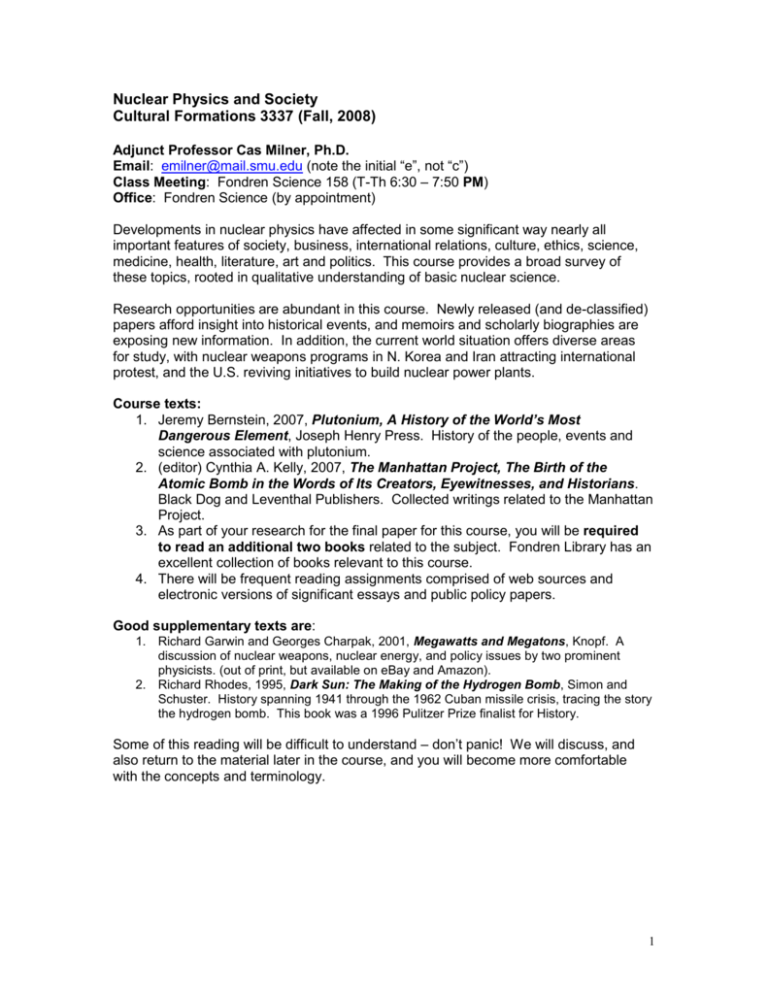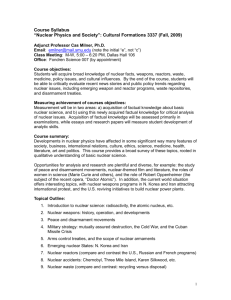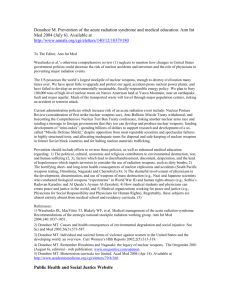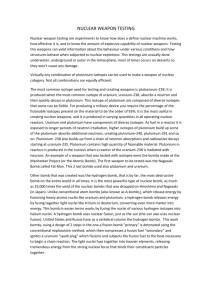Introductory Note: Nuclear Physics and Society
advertisement

Nuclear Physics and Society Cultural Formations 3337 (Fall, 2008) Adjunct Professor Cas Milner, Ph.D. Email: emilner@mail.smu.edu (note the initial “e”, not “c”) Class Meeting: Fondren Science 158 (T-Th 6:30 – 7:50 PM) Office: Fondren Science (by appointment) Developments in nuclear physics have affected in some significant way nearly all important features of society, business, international relations, culture, ethics, science, medicine, health, literature, art and politics. This course provides a broad survey of these topics, rooted in qualitative understanding of basic nuclear science. Research opportunities are abundant in this course. Newly released (and de-classified) papers afford insight into historical events, and memoirs and scholarly biographies are exposing new information. In addition, the current world situation offers diverse areas for study, with nuclear weapons programs in N. Korea and Iran attracting international protest, and the U.S. reviving initiatives to build nuclear power plants. Course texts: 1. Jeremy Bernstein, 2007, Plutonium, A History of the World’s Most Dangerous Element, Joseph Henry Press. History of the people, events and science associated with plutonium. 2. (editor) Cynthia A. Kelly, 2007, The Manhattan Project, The Birth of the Atomic Bomb in the Words of Its Creators, Eyewitnesses, and Historians. Black Dog and Leventhal Publishers. Collected writings related to the Manhattan Project. 3. As part of your research for the final paper for this course, you will be required to read an additional two books related to the subject. Fondren Library has an excellent collection of books relevant to this course. 4. There will be frequent reading assignments comprised of web sources and electronic versions of significant essays and public policy papers. Good supplementary texts are: 1. Richard Garwin and Georges Charpak, 2001, Megawatts and Megatons, Knopf. A discussion of nuclear weapons, nuclear energy, and policy issues by two prominent physicists. (out of print, but available on eBay and Amazon). 2. Richard Rhodes, 1995, Dark Sun: The Making of the Hydrogen Bomb, Simon and Schuster. History spanning 1941 through the 1962 Cuban missile crisis, tracing the story the hydrogen bomb. This book was a 1996 Pulitzer Prize finalist for History. Some of this reading will be difficult to understand – don’t panic! We will discuss, and also return to the material later in the course, and you will become more comfortable with the concepts and terminology. 1 Assignments and grading Your course grade will result from: 1. Three (3) papers (55%) [be prompt: 10% score deduction for each day late] a. ~5-page research-based essay on assigned topic, likely related to international weapons control or nuclear power initiatives (treaties, current events, etc.) (15%). b. ~2-page “Op-Ed” (letter to the Editor) essay (5%) on a current-interest topic. You will be encouraged to submit these essays for publication in student, local or national newspapers. Can be on a theme you plan developing into a topic for the final research paper. c. ~8-10 page research paper (35%) on a topic developed in consultation with the professor, and may expand upon the topic explored in the “OpEd” essay. References to include (at least) two books you have read. This assignment will include a required submission of research notes and references, in electronic form (details and templates to be supplied). Complete paper due 25-Nov-08; interim reports, earlier. d. Essays and papers will be graded on the basis of grammar, logical argument, accuracy, clarity, and reference of sources. e. Papers are due at the beginning of class. Submit them either to emilner@mail.smu.edu (doc preferred) or the old way, on paper. Ten (10) points deduction for each day late. 2. Reading quizzes (10%). a. Attendance is important, as is being current with the assigned reading. There will be frequent reading quizzes conducted at the beginning of class – do the reading and be on time for class and you will do well on these quizzes; if you don’t, you won’t. 3. Two exams (35%) a. Mid-term examination (15%), essays and multiple choice questions (28Oct-08). b. Final examination (20%), (course-comprehensive) essays and multiple choice questions (9-Dec-08, 6:30 P.M.) About the Professor I am an Adjunct Professor in Physics at SMU, and received my Ph.D. in experimental particle physics from The University of Texas at Austin. I periodically teach Phy3305, “Introduction to Modern Physics” (relativity, quantum mechanics, nuclear physics and atomic physics), and developed the course CF3337, “Nuclear Physics and Society”. In recent years, I have worked in business, applying quantitative techniques to solving business problems and managing investments. My career in physics has included designing and planning experiments for the Superconducting Super Collider Laboratory, and searching for rare kaon, pion, and muon decays at Brookhaven and Los Alamos Laboratories. I was also involved in the early design of the MILAGRO cosmic-ray telescope. My continuing research interests include particle physics and cosmic ray physics. 2







![The Politics of Protest [week 3]](http://s2.studylib.net/store/data/005229111_1-9491ac8e8d24cc184a2c9020ba192c97-300x300.png)



